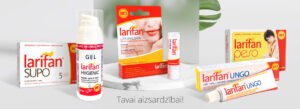GENERAL INFORMATION ABOUT dsRNA – LARIFAN
Larifan is produced biotechnologically from E.coli bacteria infected with a bacteriophage. This is an original drug developed in the second half of the last century at the Institute of Microbiology of the Latvian Academy of Sciences. (now renamed – Institute of Microbiology and Virology of Riga Stradins University).
Leading scientific institutes of the Soviet Union in Moscow, Leningrad, Kyiv, etc. also participated in the study of the biological properties of Larifan.
Since 1997, Larifan has been produced at Larifan LLC in Riga. Experimental studies (preclinical) and data obtained during clinical trials have shown that Larifan is an inducer of interferon (IFN), and the detected biological effects can be both the result of the action of induced endogenous interferon and the direct action of dsRNA molecules. Larifan has pleiotropic biological effects, such as the ability to induce the formation of interferon and cause antiviral, immunomodulatory, antitumor and antimutagenic effects.
The interferon-inducing activity of Larifan is manifested both in the body of humans and animals of various species (monkeys, calves, sheep, rabbits and small rodents).
Larifan, as well as interferon, can be considered a universal antiviral drug, since it stops viral replication in stages that are common to all viruses. The action of Larifan is determined by induced interferon, as well as the activity of the dsRNA molecule itself. The fact that the action occurs through endogenous interferon determines a wide range of antiviral effects of the drug. In experimental systems, all viruses that have been tested so far have turned out to be sensitive. The antiviral spectrum of Larifan is very wide (herpes virus, tick-borne encephalitis, соronaviruses,encephalomyocarditis, equine encephalomyelitis, respiratory infections including influenza, Sindbis, Semiliki, rabies and other viruses). Clinical experience in humans has so far shown a pronounced antiviral activity, mainly in herpes and papillomas, as well as in infections caused by respiratory viruses, including influenza, tick-borne encephalitis virus and others. An inhibitory effect on the development of chlamydia has been shown in experiments on mice.
Antitumor effects have been demonstrated in various experimental tumor models, as well as in preliminary studies in the clinic. The data obtained in experimental tumor models – on Moloney’s sarcoma, Rauscher’s leukemia, NK/Ly ascitic lymphatic leukemia, Lewis Ca 3LL carcinoma, MX-17 tumor, Ehrlich’s ascitic carcinoma, B-16 melanoma showed inhibition of the growth of primary tumors under the influence of Larifan, and especially on metastasis of malignant tumors under conditions of concomitant immunity. In the oncological clinic, a therapeutic effect was observed in basaliomas, good results were obtained in metastatic pleurisy and peritonitis.
Larifan is especially promising for immunotherapy for malignant neoplasms, since it is both an antitumor agent and an immunomodulator. Larifan activates primary immunogenesis, which is suppressed in oncopathology, activates T-cells, NK cells, and gives an immunoadjuvant effect. There are indications that there is a regulation of the expression of some genes that are important in the implementation of antitumor immunity.
An immunomodulatory effect has been shown with local and systemic application of Larifan. When applied locally, Larifan causes local lymphocytosis and an increase in the number of NK cells. Larifan in injections activates macrophages and stimulates their phagocytic activity, increases the activity of NK cells, increases the number of active T-cells, stimulates the cytotoxicity of T-lymphocytes, acts as an immunoadjuvant. Larifan affects the synthesis of a wide range of cytokines and hemokines in human lymphocytes ex vivo (Veinalde R. et al. Biotechnol Appl Biochem. 2014 Jan-Feb; 61 (1): 65-73. doi: 10.1002 / bab.1143. Epub 2014 Jan thirty)
In addition to interferon, Larifan also induces the formation of other cytokines that play an important role in strengthening the immune system.
A slight antimutagenic effect of Larifan was found.
Preclinical tests have shown that Larifan does not have carcinogenic, mutagenic, locally irritating and allergenic properties. Clinical observations indicate harmlessness to humans and good tolerability.
The clinical efficacy of Larifan is evidenced by observations obtained as a result of the use of injections, as well as many years of experience in using the ointment form of the drug. Larifan injections have been tested in the clinic as an antiviral drug for herpes and tick-borne encephalitis and as an immunomodulating agent for secondary immunodeficiency and in cancer patients. Larifan in ointment form and in suppositories has a pronounced therapeutic effect in recurrent herpes, as well as in sexually transmitted diseases. Highly sensitive to Larifan are proliferative processes caused by the papilloma virus – warts, papillomas, condylomas.
A line of products has been created in which a double-stranded RNA called Larifan is included as an active substance. These products are:
1) Dosage forms,
2) Wide application products,
3) Cosmetic products
The line continues to expand
The active substance, dsRNA, is produced by Larifan LLC in Latvia in accordance with GMP requirements.
The method of obtaining Larifan is patented.
